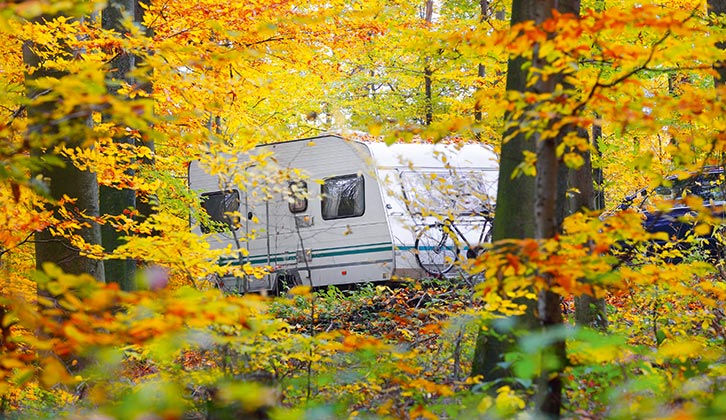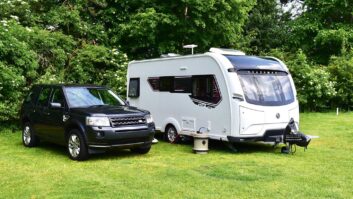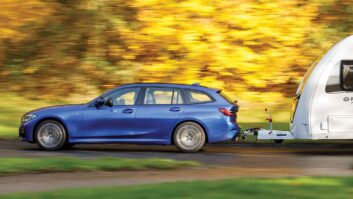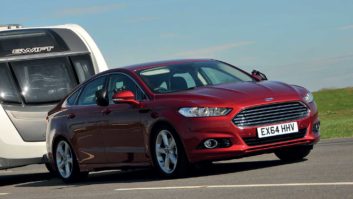While some tourers will be tucked under their caravan covers for a few months of hibernation, others are used whatever the weather, which will inevitably involve towing in winter.
Modern construction and heating make tourers as warm and comfortable as any home, even when it’s chilly outside.
Four-season caravanners are rewarded with quiet campsites, crisp morning walks, and a comfortable chair next to the fire in their favourite pub.
Touring all year round is just great. Towing all year round – particularly in winter – can be more of a challenge. You’ll need to prepare both vehicle and van well – and expect the unexpected.
- If you’re thinking of taking a winter tour, our best caravan heater guide will help you find the right product to stay warm.
Autumn towing
The most challenging driving conditions come in winter, but before we reach the coldest months of the year, there’s still autumn to get through, when you can face towing a caravan in the wind.
At its best, this can be one of the most rewarding times of year to go caravanning. But the weather can make towing in autumn more difficult. Autumn gales, for example, can be stressful.
It pays to keep a close eye on the weather forecast in the days before you plan to go away. If high winds are predicted, it might be wise to change your travel date, if you can.
Think about the route you take, too. For example, crossing the Severn Bridge in high winds is no fun, and the bridge could even be closed. Consider going the long way around instead, so you stay further inland and away from where it’s windiest and most exposed.

Rain can be another hazard when towing in the autumn. In wet weather, it pays to leave a larger gap between you and the vehicle in front.
When you learned to drive, you were probably taught about the two-second rule, and told to double it in wet weather. In other words, if you pick a spot up ahead and count from the moment the car in front passes it, you should be able to count to four seconds before you pass the same spot.
If anything, an even bigger gap might be appropriate while you are towing in the rain, as the stopping distance for a car and caravan will be greater than it is for a car driven solo.
Another favourite motto of driving instructors everywhere is “The speed limit is a limit and not a target.” In wet and windy weather, dropping your speed by 5mph or more can make a noticeable difference to stability and should result in a less stressful journey.
Two-wheel drive or four-wheel drive
As the mercury drops further and there’s a risk of snow and ice on the roads, you might wonder whether four-wheel drive is essential. Sending power to four wheels rather than two is beneficial in wet and cold weather. It makes wheelspin less likely, and hill starts and pulling away from junctions will be easier.
Four-wheel drive could make the difference between being stuck on a pitch or being able to tow away unaided.
But don’t be put off towing in the winter months because you own a two-wheel-drive car. The likelihood of snow varies hugely around the country. According to the Met Office,
we get an average 23.7 days of snow across the UK as a whole. But in Cornwall, there are just 7.4 days of snow or sleet. Unsurprisingly, you are much more likely to encounter snowy conditions in Scotland, with 76.2 days of snow or sleet in the Cairngorms.

There are, of course, no firm guarantees with British weather, but if you are towing in the south and avoiding high ground, you’ll be unlucky to encounter much snow while caravanning.
By contrast, the further north you are and the higher up, the more important it is to plan to cope with snow and ice.
Winter tyres
Even the best cars for winter towing with four-wheel drive is only of so much benefit if you run summer tyres throughout the year. Spend time in Scandinavia during the winter and you’ll see plenty of two-wheel-drive hatchbacks coping with snow and ice, because they are fitted with the right tyres for these road conditions.
Winter tyres deliver better grip than summer tyres once the temperature drops to 7˚C or lower. Extra sipes (thin slits) in the body of the tyre help winter tyres to shift water from the road surface better than summer ones, while their softer rubber keeps the tyre supple and grippy in the cold.
The initial cost of another set of tyres might be offputting, but you are prolonging the life of your summer rubber, so the long-term cost isn’t actually as great as it first seems.
Even so, you might prefer the convenience of an ‘all-season’ tyre. These are a halfway house between the summer tyres most of us use in the UK and winter tyres. Examples include the Michelin CrossClimate Plus and Goodyear Vector 4Seasons.
Such tyres won’t be as grippy on bone-dry roads as the best summer tyres, and they won’t match the performance of a proper winter tyre on snow or ice. But as a fit-and-forget four-season option for the British climate, they’re going to be hard to beat.
If you do stick with summer rubber, a set of snow chains or socks for the driven wheels is a wise investment. You might never need them, but keep them in the boot just in case.
Prepare your caravan for winter towing
Make sure your van tyres have plenty of tread and are inflated to the correct pressure.
Running out of gas in summer is inconvenient, but it could be more serious if you are relying on gas heating in winter. Make sure you have enough gas for your stay and test the heating before you set off.
Remember, with an electric hook-up, you might struggle to keep warm, because the heating won’t be as powerful as when running on gas.
Ready for anything
Even if you keep an eye on the weather, and prepare both car and van, you should be ready for trouble on the journey, or the failure of the van heating.
Pack a snow shovel, and keep food and water in the car in case you are stranded. Warm gloves, coats and boots are essential, and an emergency blanket can help you keep warm if your vehicle breaks down.
Tips for winter towing
Don’t be put off, though. We’re talking about preparing for the worst to give you peace of mind, not listing reasons to worry. With the right planning and kit, towing all year can lead to wonderful holidays that will match any summer getaway.
- Keep an eye on the weather forecast – Be ready to change your route or even delay your trip if necessary
- Watch your speed – Drive more slowly in wet, windy or wintry weather and leave a bigger gap to the car in front
- Take care of your tyres – Plenty of tread and correct inflation are essential, while four-season tyres make a great deal of sense for British driving conditions
- Prepare your caravan – Make sure your van heating system works as it should, and you have plenty of gas
All images: Getty
If you enjoyed reading this, why not take a look at these:
- David Motton shares his caravan towing tips to help you stay safe on the road
- Take a look at the different types of caravan to find out about their differing pros and cons
If you’ve enjoyed reading this article, why not get the latest news, reviews and features delivered direct to your door or inbox every month. Take advantage of our brilliant Practical Caravan magazine SUBSCRIBERS’ OFFER and SIGN UP TO OUR NEWSLETTER for regular weekly updates on all things caravan related.
Avoid travelling on less-used roads or country lanes as these are less likely to be gritted








